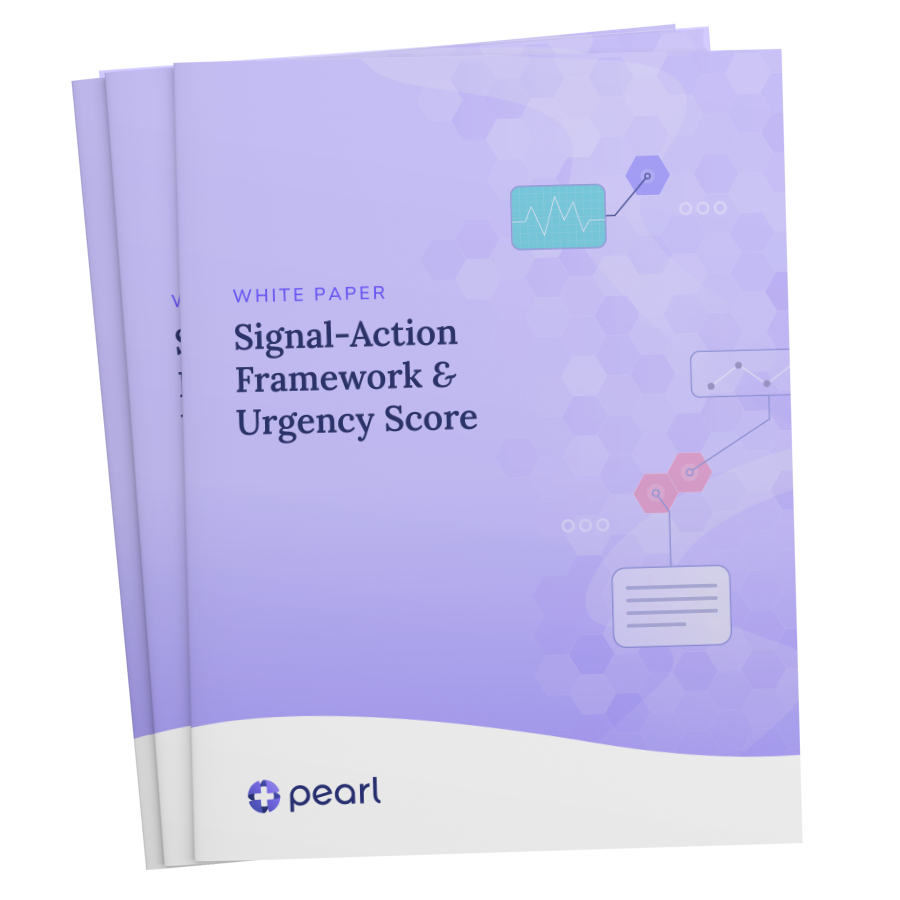Our healthcare system is in the middle of a revolution. One that finally puts patients at the center of care and equips providers with the payment models and support needed to deliver that care. This revolution — the shift from volume to value-based care — continues to gain traction across payors and providers. For example, the Centers for Medicare and Medicaid Services (CMS) — the largest healthcare payer in the US — plans to bring all Traditional Medicare patients into accountable care relationships by 2030.1
Providers bring the will to deliver patient-centric care. Payors are bringing the way. So what, if anything, is missing?
The challenge of powering value-based care with fee-for-service technology
To succeed in value-based care, providers must broaden their scope from treating the patients already in their waiting rooms to proactively identifying and engaging with high-risk patients who may be slipping through the cracks across their entire patient panel. Then, when engaging, they must treat their patients holistically, going beyond lists of individual care gaps flagged by population health tools.
Unfortunately, while valuable for specific use cases, today’s widespread technology solutions were created to enable traditional fee-for-service care. In a value-based care world that tasks providers with identifying and preventing acute events or worsening conditions, legacy technology platforms that focus on billing, lagging indicators of health, and retrospective analysis fall short.
Before jumping to the solution, let’s start with the role and limitations of today’s technology.
EHRs: A double-edged sword that drives better data — and burnout
While electronic health record (EHR) systems were developed decades ago, they did not see widespread adoption until after 2009, when CMS introduced the Health Information Technology for Economic and Clinical Health (HITECH) Act.2 HITECH established the Meaningful Use program, which set standards for EHR adoption and utilization, while also providing strong financial incentives for EHR adoption.
HITECH helped propel EHR adoption to almost 100% for health systems and 80% for office-based physicians, which ultimately improved data collection, organization, and interoperability — all critical enablers for effective value-based care.3 However, this adoption came at a cost, with providers taking on much of the burden of capturing the required data.
Fast-forward a decade and we see the inevitable result: 75% of physicians experiencing burnout identified the EHR as a key contributor, and 50% of PCPs feel that EHRs take away from their clinical effectiveness.4 5 Many physicians would say these statistics are due to the fact that EHRs were created primarily as billing tools. Regardless, EHRs are not going away, and it is unsurprisingly difficult to focus on delivering patient-centric care when providers spend more than half their workday interacting with EHR systems — during and after clinical hours.6
“There is building resentment against the shackles of the present EHR; every additional click inflicts a nick on physicians’ morale”—Donna Zulman, MD, MS; Nigam Shah, MBBS, PhD; and Abraham Verghese, MD, MACP7
The good news? EHRs have improved substantially, and many now offer better support for clinical workflows and patient visits. However, EHRs remain focused on the point of care — they were designed to support a world where the appointment was considered the primary unit of value — so they rotate entirely around the visit workflow. In many EHRs, the only way to engage clinically with a patient is via a visit workflow in the EHR. This limited usefulness in identifying and addressing healthcare needs at the panel level left room for the emergence of a separate technology platform to fill that gap.
Population health tools:A wide, but shallow, view of patient needs
Throughout the 2010’s, what started as a need for improved clinical data reporting evolved into superior analytical tools referred to as population health management platforms. These tools acted as a valuable complement to EHRs, enabling healthcare organizations to expand their visibility and patient engagement efforts outside the visit.
Population health tools enabled healthcare organizations to track quality measures, stratify patients by risk, and create chase-lists — all invaluable capabilities for closing care gaps, increasing HEDIS scores, and improving the overall quality of care. According to a recent study, primary care practices achieve significantly better patient outcomes when a population health management tool and a value-based payment model are layered over the existing EHR system.8
That said, despite the improvement they offer, population health tools still fall short of enabling the kind of patient-centric care needed to unlock the full potential of value-based care.
First, most population health tools surface insights at the organizational level — not the provider-level. This means that providers and their clinical staff get useful lists of care gaps, but they only receive pieces of the puzzle. They receive one-off tasks — checklists to work through — rather than a holistic view of which patients need their attention and what longitudinal care insights are most relevant for delivering whole-person care.
Second, population health tools generally provide retrospective analytics and reporting focused on care gaps, quality scores, HEDIS measures, and risk adjustment codes. Providers in value-based care need retrospective data, but they also need predictive recommendations — signals that identify patients at high risk for preventable ED visits, unplanned admissions, and more — that enable addressing patient needs before they become worse.
Third, these tools are typically only accessible to large, complex organizations that have the funds, teams, and in-house expertise to receive the data and turn it into workflows. Smaller clients are often left working off of reports pulled from their EHRs or lists from payors, which limits their ability to optimize workflows and patient outcomes.
Providers need a new solution to enable patient-centric care — one that complements EHRs and addresses the limitations of population health tools. So, what comes next?
Patient-centric enablement: the next
evolution of technology for value-based care
Fundamentally, physicians and their teams are looking for patient-centric technology to help them focus on the right patients with easy-to-use, tactical workflows that help them engage those patients and improve their outcomes. They also want to understand the cumulative impact of their actions so they can improve over time. It’s not just about data insights, but about surfacing those insights in a way that makes it easier for providers to call the right plays for their patients, at the right time — even if the right time occurs outside the four walls of the practice.
Although population health tools are effective for highly-resourced and experienced organizations that need to make system-wide decisions, Pearl Health recognized a need for technology to practically support the last mile of care with a new class of physician enablement technology. So Pearl Health embarked on a journey to build it from the ground up. The Pearl Platform empowers providers to succeed in value-based care with technology that helps them:
- Identify at-risk patients and holistic care needs across preventive (e.g., due for an Annual Wellness Visit), acute (e.g., transition of care), and predictive (e.g, preventable ED visit) needs;
- Engage patients via a simple, prioritized workflow that recommends the next best action for each individual to improve outcomes and reduce downstream costs; and
- Align financial incentives with acting on timely, proactive care recommendations from the Pearl Platform to drive engagement and patient outcomes.
What do these platform capabilities translate to in the real world?
Happier and more fulfilled providers. Pearl earned an NPS of >70 in our most recent customer survey.
Better patient care. Providers in our network reduced the percentage of high-urgency patients in their panels by 30% last year.
Healthier patients and measurably lower costs. For example, each post-discharge follow-up visit scheduled based on Pearl’s recommendations leads to a 4.7 percentage point attributable reduction in readmissions and $377 in savings.
Value-based payment models like the Accountable Care Organization Realizing Equity, Access, and Community Health (ACO REACH) Model and the Medicare Shared Savings Program (MSSP) provide the vehicles for patient-centric care. Pearl’s technology platform — layered on top of the EHR — provides the fuel to help providers get there.
Our Technology
- Centers for Medicare & Medicaid Services, “CMS Announces Increase in 2023 in Organizations and Beneficiaries Benefiting from Coordinated Care in Accountable Care,” January 2023.
- HIPAA Exams, “The HITECH Act and Meaningful Use of Electronic Health Records,” July 2021.
- Office of the National Coordinator for Health Information Technology, “National Trends in Hospital and Physician Adoption of Electronic Health Records,” 2021.
- Journal of Medical Internet Research, “The Influence of Electronic Health Record Use on Physician Burnout: Cross-Sectional Survey,” July 2020.
- MedCity News, “Unsurprisingly, physicians aren’t thrilled with their EHRs,” June 19, 2018.
- Annals of Family Medicine, “Tethered to the EHR: Primary Care Physician Workload Assessment Using EHR Event Log Data and Time-Motion Observations,” September 2017.
- JAMA, “Evolutionary Pressures on the Electronic Health Record: Caring for Complexity,” 2016.”
- HealthITAnalytics, “Population Health Management Tool Improves Primary Care Outcomes in VBC Model,” October 12, 2022.




